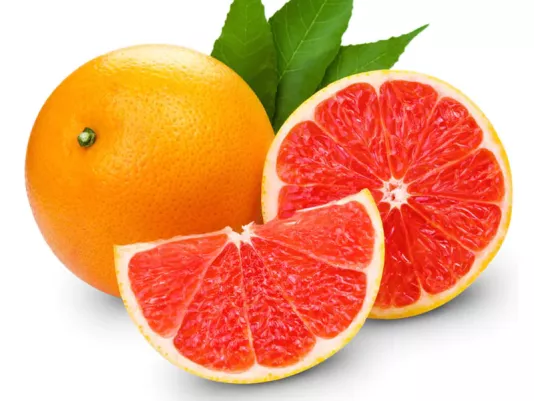Candied Grapefruit Rinds
Candied grapefruit slices are a French recipe, a simple sweet and a simple dessert.

Grapefruit is the citrus that taught me to respect the balance of flavor. Over the years of working with it, I’ve realized its strength lies not only in its refreshing tartness but also in the subtle bitterness that reveals the depth of any dish. Ripe fruits have smooth, glossy skin and a light aroma of essential oil. I always choose those that feel heavier than their size – they hold more juice. When I cut it open, I sense a soft citrus fragrance – that’s what defines its quality. In cooking, grapefruit helps create balance between sweet and sour, and its vibrant color adds visual appeal. I’ve come to believe this fruit fits not only breakfast but also complex sauces, salads, and desserts. Everything depends on the right approach and precise understanding of its nature.
When I choose grapefruits, I always pay attention to their weight, skin texture, and aroma. Experience shows that a light, porous, or too soft fruit has already lost some of its juice, meaning its taste will be dull. The best ones are dense, heavy for their size, with evenly colored skin free of dark spots. Thin skin doesn’t always mean sweetness but gives more pure pulp. The color – from pale yellow to pinkish red – is just a guide: what matters most is that the peel shines naturally, without excess wax. I always press the side of the fruit gently: firmness without dents indicates freshness. If the scent is barely noticeable, the citrus was likely stored too long. A truly ripe grapefruit has a subtle aroma reminiscent of orange with a hint of pine. When buying in winter, I check the country of origin: fruits from warmer regions are less acidic. Even the best grapefruit should be eaten in time – after a week in the fridge, the flavor is no longer as clean.
Preparing grapefruit requires care, as it determines how gently its bitterness will be felt. I start by rinsing the fruit in warm water to remove surface wax and dust. Then I peel it with a thin knife, trying not to touch the white layer – that’s what adds unpleasant bitterness. When I need clean segments for a salad, I use a small sharp knife to separate the slices between membranes. It takes patience, but the result is worth it: pure juice and a tender texture without fibers. If I plan to use the zest, I grate only the colored part, avoiding the white – the aroma will be brighter, without harshness. Store sliced grapefruit in a glass container with a lid in the refrigerator for no more than two days: the juice oxidizes quickly. I’ve noticed that contact with metal darkens the flesh, so I use stainless steel knives. For marinades or desserts, I squeeze the juice by hand to avoid damaging essential components that are lost with strong heat.
Grapefruit doesn’t tolerate high heat – a lesson I learned after dozens of experiments. Its essential oils evaporate quickly, and the acid can develop a bitter aftertaste. If I need to bake it, I do so briefly at no more than 180°C (355°F) with minimal sugar. The pulp lightly caramelizes but stays fresh. When making sauces or glaze, I add the juice at the end, after removing from heat: the aroma remains clean, not “cooked.” It’s important not to overheat the dish – grapefruit loses its structure and turns into a sour mash. For a warm salad, I heat the segments for only a few seconds on a dry pan: the surface dries slightly while the inside stays juicy. When pairing with meat or fish, I always let the fruit cool before adding – the temperature contrast enhances the flavor. My experience shows that light warming makes the aroma more delicate, while boiling or baking for more than 10 minutes destroys its natural bitterness.
Grapefruit beautifully enhances the taste of other foods when the proportions are right. In my experience, it pairs best with seafood, soft cheese, avocado, chicken, and fresh herbs. Its tartness balances richness, while its mild bitterness adds depth. In salads, I always add a pinch of salt – it highlights the sweetness of the pulp. When working with desserts, I reduce the sugar: too much masks the citrus sophistication. Grapefruit juice in marinades tenderizes meat proteins, but I never leave it too long – after an hour, the acid starts to “cook” the food. In sauces, it blends harmoniously with honey or olive oil, creating natural balance. Another key detail – aromatic herbs: basil and rosemary deepen the taste, while mint adds freshness. When I cook for guests, I use grapefruit as an accent rather than a main component – that’s when it works best, complementing rather than dominating.
The most common mistake is underestimating grapefruit’s intensity. I’ve seen dishes where too much is added, and the whole composition loses balance. It’s important to understand that even a few drops of juice can alter a sauce or dessert. The second mistake is using old fruits: their juice becomes bitter and cloudy. I always recommend checking aroma and color before use. If the flesh looks dull or dry, replace the fruit. Avoid combining grapefruit with overly acidic ingredients – lemon or vinegar overpower its natural delicacy. When serving, steer clear of metal tableware, especially aluminum: it reacts with the acid and changes the taste. Another thing I’ve learned – storage. Grapefruit dislikes sudden temperature changes, so don’t keep it near the freezer. If you need to prepare juice in advance, pour it into a glass bottle, seal tightly, and use within a day. That’s how its natural freshness and aroma – the very qualities that make this citrus so appealing – are preserved.